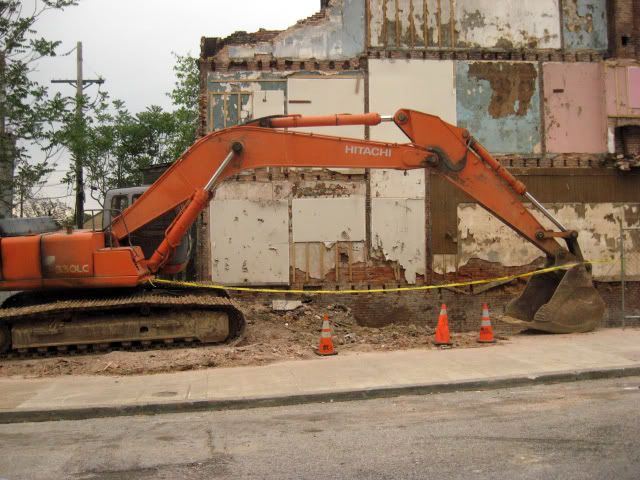
Its sad, but building decay is becoming a major issue for some U.S. cities on the East Coast and Midwest. Many architecturally significant buildings stand vacant in economically depressed or otherwise undesirable areas and as they approach 100 and 150 years, the elements begin to slowly take their toll.
Alan Weisman's book The World Without Us goes into great detail on how long human structures can last when we aren't taking care of them--and once water is allowed to enter a structure, it usually isn't very long.
Baltimore is fast becoming a perfect example of what a city with too many forgotten buildings comes to look like. The suspicious empty grass lots to be found at the corners of blocks in certain Baltimore neighborhoods are not the planned gardens and green spaces they might appear to be, but actually uncontrolled, "natural", like-it-or-not demolition of the city's built heritage.
A good example of this phenomenon can be seen on Google streetview here.
Is that what the corner of Greenmount and Preston will look like in 5 years?
Here's the corner of the block (courtesy Google) before this week:
View Larger Map
..and as it is now.

It may not have been a building worth preserving, but I doubt it was a building worth demolishing. I think that during a period in which people put so little thought into building sustainably (see: suburbia) the loss of even one medium density building with potential charm and a real history is sad. The funny thing is, these buildings were the suburban tract homes of the 1910's!--except then they were served by streetcars and supported a denser population.
A cool site I discovered recently, Built St Louis, discusses this issue in depth as it occurs in St. Louis, MO. Both Baltimore and St. Louis have been struck by similar historical misfortunes (B.S.L. outlines them very well here.) including white flight to the suburbs and the resulting population loss. In the 1950's Baltimore had a population nearing a million. That number teeters around only 650,000 today. Nobody's left around to take care of all the elderly buildings. sad!
-G

6 comments:
This is really going to ruin my view when I eat at CHICKEN NOOK
Maybe they can buy the empty lot and put in a nice picnic area. Whenever I go by they seem to be doing brisk business.
Yeah... their Lake Trout is the best!
<3 this blog.
Keep blogging! Would be a neat contrast to my blog (the River Mud Blog) which focuses on Maryland's natural environment, and Walk The Old Line, which focuses quite a bit on abandoned Maryland.
PS I used to take Greenmount to North Ave to work. Some beautiful rowhomes down there...and they will never, ever be restored.
Thanks for the support!
Post a Comment